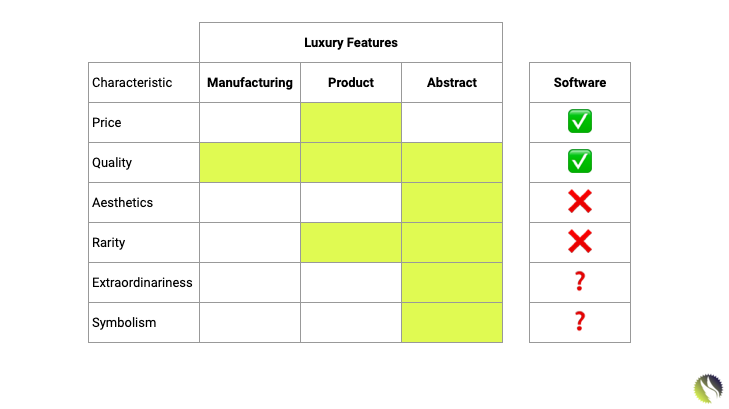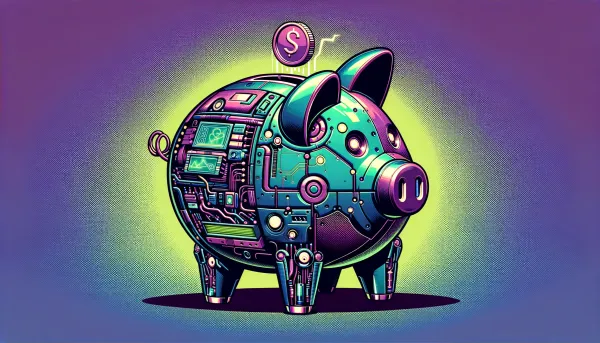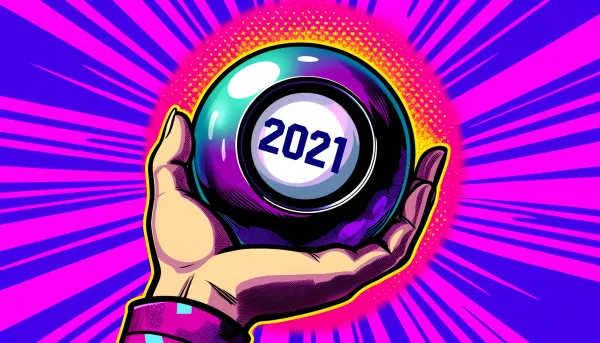Is Luxury Software a Real Thing?
The trend towards niche, premium-priced products aimed at power users, poses a question of whether luxury software brands is a new category in the digital realm.

A tweet I saw in 2019 stayed on my mind and comes up now and again:
I hear about a team building "Superhuman for X" almost everyday.
— Jeff Morris Jr. (@jmj) July 22, 2019
A new category of companies is being built in a space which I call luxury software.
We have luxury goods in our physical lives: cars, fashion, homes.
Luxury software will be built for every tool we use at work.
An interesting concept for sure. But one that seems contradictory given the essence of software and luxury:
- Software strives for zero marginal cost, reached with critical user mass
- Luxury limits supply to increase margins from a finite number of customers
Combining the best parts of each comes to an investor nirvana: zero marginal cost with high, consumer surplus-capturing prices. But, can it be achieved?
It is one thing to espouse luxury and another to be luxury. An innate feature of luxury watches, cars and bags are that they endure throughout generations of war, booms and busts. The staying power of a brand gives confidence in its quality and compounds brand cache. Consumer software is still relatively recent, suggestions for adding luxury as a prefix to some premium services is an externality derived from a range of evolutionary market headwinds:
- Referral: Power and popularity of invite-based acquisition
- Vanity metrics: Warm fuzz of hype cycle waitlists
- Specialised nuance: More digital needs for power users that can't be met by all-in-one suites, fitting into macro themes of subscription and unbundling
- Revenue focus: Over past promises of revenue from scale and freemium
- Defensibility: An angle for startups to compete outside of GAFA's orbit
- False-positive feedback loops: Tech investors funding products they want to use themselves
Driving trends forward has been another recent sociological trait, which may supersede the factors above: digital virtue signalling.
What is Digital Luxury?
The mystique of luxury is that success cannot be codified into a playbook. When you look at traditional luxury brands, their beginnings were typically a combination of humility and intense dedication to a craft, which over time spins into a narrative story underpinning the brand's virtues: quality, tradition, bespoke. Contemporary parallels with technology ring true: substitute the Milanese garment workshop for a San Franciscan bedsit.
The most academic research I found that describes a framework for luxury comes from Klaus Heine, who categorises them into six factors across three variables. Of these, I see software having an even split between compatibility, potential and unsuitability:

Let's look at how this is so.
Price
At scale, luxury is more pervasive in the goods industry. Luxury services - e.g. travel and concierge - rely on bespoke, hands-on offerings and thus, have the requisite attractive markups. Services are often intrinsically tied to a single person's career attributes and phone book, which until we start cloning each other, is awkward to scale.
Gold-standard public SaaS gross margin benchmarks target the 80% range, which is analogous to where global public luxury companies cluster around:

Comparing the business models of luxury goods to software is an apple and pears situation. The former comes with high top-and-bottom line cost bases, from the quality of materials used, to a high-end marketing machine propping it up. Software costs are higher on the operating side, with massive spending on continual product development.
Where premium software products display discernible luxury traits is how they're priced. Luxury houses price by brand, which allows them to target different customers tiers without brand dilution, for example, The Swatch Group comprises Longines and Tissot, both markedly different from a price perspective. While most software traditionally comes with a selection of tiers ranging from freemium up to enterprise, in premium, free services (and generous trials) are progressively eschewed for straightforward paid levels.
High price elasticity is an inexorable externality of a luxury product, how goods companies limit downside is through post-sale maintenance, which retains customer wallet and keeps the brand top of mind, in the absence of purchases. Software employs similar tactics, the risk of churn is always manifest, but premium features and data moats build defensibility.
Verdict: Compatible ✅
Quality
Software's monthly payment cadence establishes a trust bond between consumer and supplier; retention is predicated on maintaining - and exceeding - quality expectations. So all good here.
The argument against software having luxury traits is that at scale, quality control is arduous. When companies begin they tend to have hands-on in-person support, as they scale, this regresses into self-service options like bots, outsourced providers and wiki FAQs. Limiting customer numbers and deploying high price points through a luxury strategy allows brands to maintain levels of support. Superhuman is a premium email software with an in-person onboarding process, which may seem un-scalable, but establishes quality control mechanisms.
Evangelism for Superhuman on social media has enhanced its reputation. It affirms how software quality can have luxury traits when there is a heavy-human touch behind it, not merely excellent code quality.
Verdict: Compatible ✅
Aesthetics
Luxury good aesthetics are subjective, but the distinctive nature of a brand helps them stand out and gain recall. Software design changes tend to all shift in the same direction of thematic trends in UX and UI design. If you look at the evolution of software appearance (e.g. button design), you see that software building blocks mostly evolve in unison.
Once a brand has an excellent interface, features of it will inevitably end up copied by the rest. See how night mode has gone from an intriguing differentiation to now complete ubiquity.
Verdict: Unsuitable ❌
Rarity
The rising popularity of waitlists synthesises the appearance of software scarcity. Superhuman, again is an example, as is the buzz that surrounded Clubhouse during the 2020 lockdown. As dating apps bifurcate further into subcultures, you see some, like Raya and The League, using exclusivity as their velvet cordon: limiting signups to qualification based on attributes (e.g. celebrity status and career achievement). Luxury goods create rarity through material means (i.e. their cost); digital luxury focuses on intangible prejudice.
Online gaming has also evolved from unfair advantages of paid enhancement bolt-ons to now, with rarity signified through aesthetic in-app purchases. In digital realms, this is a form of virtue signalling,
Digital rarity is a manufactured construct. While luxury goods companies could feasibly supply more, the desire to protect brand buffers such urges. Old season stock is often destroyed, rather than discounted. For software, perceived rarity is a state of mind that's often encouraged to establish a walled garden beachhead, which over time, becomes a tempting itch to scratch. Rarity derives from principles of lean startup methodology: making incremental steps to safely validate a product, over entrenched desires to build enduring luxury customer bases.
The temptation to build outward once validated erodes luxury. Facebook and luxury don't usually go together in the same sentence, but it was initially only available to those with college email addresses. Once validated, it was inevitable that Facebook would open up, and I remember the furore at university around 2006 when the floodgates released.
Lack of patience is another downfall that limits rarity in software. Metal bank cards seemed like an exciting idea for Fintechs to establish brand premia; American Express' Centurion card is the stuff of legend, with even its delivery being an event. Fintechs priced metal cards modestly and offered inferior perks; now, every neobank offers one and signalling leans more to crassness, over opulence.
Verdict: Unsuitable ❌
Symbolism
Luxury goods offer owners means to make statements, being vehicles of outward expression. Luxury products are perceived based on elements like nationality, old/new money vibes and celebrity brand ambassadors. I see this having a diminished effect in the digital realm. For digital, the quicker trend cycles and borderless natures (in terms of access and expressive nuance) limits symbolic impact.
Perhaps this will emerge as time progresses. Take free email services from the 1990s; they have an inert social hierarchy. When you see a Yahoo, AOL or Hotmail address, one side of you thinks that you are talking to a web "veteran", but the other says that you are corresponding with someone who is not savvy: they are using an inferior product. When Basecamp launched its Hey email offering in 2020, it acknowledged the value of shorter email addresses and placed increased cost for those wanting three, or four, character usernames.
Physical symbolism is more subtle, which furthers allure; users control when it's expressed. A "Sent by Superhuman" signature may make a statement on a new client email, but when blanketed on all correspondence, is a blunt instrument.
Verdict: Questionable ❓
Extraordinariness
Such an adjective is hard to quantify; the Heine study distils extraordinariness into four features:
- Different design or construction principle
- Innovative functional attributes
- History or its manufacturing process
- Brand image
Coalescing these factors into a luxurious software offering is an ambiguous proposition. The first two, for example, are achievable, but very difficult to maintain as proprietary IP. Snap Inc. has unwittingly become the R&D lab of Facebook; every time it releases popular new features, Instagram inevitably replicates them. Software code is proprietary but can inspire competitor replication through legal, or reverse-engineered ways. Counterfeiting blights the luxury goods industry, but its long-term protection from fake goods links back to aesthetic and symbolic qualities. Most people don't want to own a fake luxury good. Loyalty to software is more fluid; it's less of an investment, and brand history resonates less.
The most luxury way I can conceptualise how a software brand can be extraordinary would be through company intangibles: such as cultural standards and internal meritocracy.
Brand image is the most cast-iron way of defining software luxury; Apple is the textbook example. The value attached to a founder also has parallels to the way luxury brands are spearheaded by founding families. When founders depart software companies, the difficulties they may then endure going forward is a link to the connection between founder and brand. Uber is not luxury, but its industry-transcending brand recall tied to the dogmatic relentlessness of its founder, Travis Kalanick. Since his departure, Uber has become just another (albeit large) rideshare company.
Verdict: Questionable❓
Luxury Software: Accident or Consequence?
Unbundling is a trend that has stimulated the rise of speciality software services that shun free pricing tiers. The buzz that surrounds supposed "luxury" offerings - like Superhuman - is a rational sign of a shift to premium in a world with more realistic TAMs. Such moves are luxury by accident, elevated by a foamy mix of virtue signalling, hype-driven marketing and significant improvements on the tired and pervasive Google, Microsoft and Apple incumbents. Bundled productivity services move slow, they must appease a global audience and are flagship loss-leaders, deployed to upsell or tie users into an ecosystem.
The bar is very low for focused startups to improve upon incumbent bundles and the premia charged is more a validation of consumers' increasing willingness to pay for digital services with money, not their data or advertising eyeballs.
As discovery increases, lives further digitalise and the captive audience wallet share for premium digital products increases. The "luxury" providers that emerge will have the cash flow and fervent userbases to build sustainable businesses. Ironically, their most apparent path to exit will be as an acquisition from the large tech conglomerates that they compete around.




